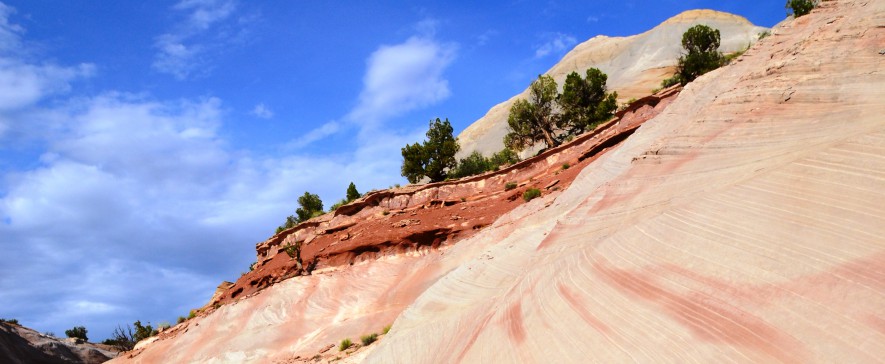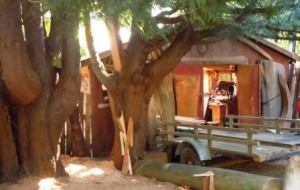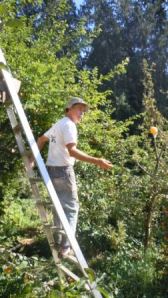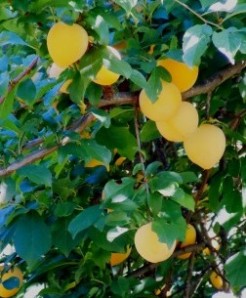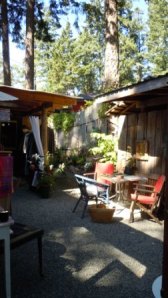What is simplicity?
Perhaps it’s hospitality that offers you what you want before you know it exists. It’s an artful eye turned to transforming scraps of wood into beautiful, functional furniture. It’s a relationship with the land, a passion for apple trees, and gift for creating community. And, it’s all down a road with broken pavement on an island called Salt Spring.
Every place has its own language, speaking to you through its history, the actions of its people, the architecture, the food, and the terrain. New York City, for example, shouts out the limitless human potential to create and to build. It speaks of the American Dream with its millions of people from all over the world hustling about, working to build their lives. As a contrast, on the opposite side of the continent, Salt Spring Island, one of the British Columbia Gulf Islands, is a lecture on blending with the land; an oration on community; a discourse on carving a simple and rewarding life amid fir trees, rocks, and tides.
Granted, the island is not the quiet backwater it once was. Tourism promoters bring hordes of summer tourists to the island. Developers entice wealthier mainlanders to Eden with promises of solitude, culture, and seaside living. Yet, if you venture off the main roads you’ll discover the best kept secret of the island, the island’s true asset – its creative and hardworking residents. One such road is King Rd., which leads to Stevens Rd., which leads to Heidi Place and a wonderful world away from it all.
The road branches off of the main paved route to Ruckle Provincial Park . Through a tunnel of firs and maple you dodge potholes, washboard ruts and gravel berms. But, don’t let the rough road surface dissuade you from your purpose, for down this road several wonderful destinations await.
First, you’ll find Copperwood Gallery. Tucked amid several gnarled conifers, two small buildings provide the workshop and gallery for Luke Hart-Weller. He’s an artist, a woodworker, a friendly and young fellow. So much talent for his few years. His ability to make a piece of salvaged wood into something other than a rustic novelty is inspiring. I can only imagine his creative process. Perhaps as Michelangelo saw David in a block of marble, Luke sees tables, and chairs, and benches in drift wood. No question, you should see his work.
Lucky for us he was there when we stopped by. He showed us his masterpieces in waiting (aka logs) and some of the simple tools of his trade, explained the process of selecting and obtaining wood, gave even a little overview of the legal aspects of salvaging wood. But he also showed us the possibility of reaching ones creative potential where inspiration wafts down from the tree tops and rises from the roots and mycorrhizae of the forest floor.
Already charmed by our Copperwood encounter, we jump back in the saddle and pedal to our next destination: Apple Luscious Organic Orchard. It’s September and the promise of fresh apples propels us down the road, around a curve, and partly up a hill, where a rustic wooden fence and gate pronounce our arrival. If you’re expecting to see orderly rows of plump monoculture trees, think again. Farmer Harry Burton has other ideas. He’s farming a wild orchard, using more ancient methods of tree stewardship, embracing heritage and heirloom apple varieties, and farming in ways more attuned with the land. So, rather than stand out as tilled plot of land, his farm blends in with the surrounding forest of tall, stately cedars. It appears more like a forest meadow than a food-producing plot. But, oh so productive it IS.
At Apple Luscious, 200 varieties of apples, most of which you’ve never heard of, grace the acreage. Apples and apple trees of all shapes, shades, and size are peppered among herbs, flowers, berry vines and grass. Chickens range among the forbs growing below the trees and like us, sample the fallen fruit. Bumble bees and skippers nectar on the flowers. The mower only cruises the path to and around the trees, no road way for trucks exists. Currently, the path is only wide enough for wheelbarrows, and no mechanization is used.
Harry is most obliging in leading you down his pathways. He entices you with samples of plums the color and taste of the sun, pink-fleshed apples, and a wealth of knowledge if you’re willing to listen. What’s marvelous is that he offers all of this without mention of exchange, there’s no sign pronouncing the fee for the tour or the tasting or the education. Yet, in the midst of the marathon of apple picking season, he stops work to share his passion. Certainly he is very busy. In addition to the fall harvest, Harry also helps organize the Salt Spring Island Apple Festival in October. After visiting Apple Luscious and hearing about the fete from Harry, I have no doubt that this is one of the premier apple festivals in North America. I hope to return some day to experience the event.
It was only natural that at the end of the tour we purchase fruit at the newly completed Apple Heaven (the name of his fruit stand). Then, we head back down the road dreaming of the plums earmarked for dessert later in the evening.
Now, nearly a week later, and there are two things I can’t get off my mind. First, Harry’s enthusiasm for apples and his generosity are nearly startling, yet they are most certainly uplifting. In Japan, perhaps, he’d be proclaimed one of the living treasures: a master of his trade, a sage and wise teacher, humble yet confident in his knowledge of the world. Here, on Salt Spring, he’s one of several farmers embracing the old ways and inspiring future generations. Second, the sight of the beautiful fruit he grows. Somehow, in the wild orchard setting every fruit looked like a delicacy (and indeed many are), the incredible yellow plums ripe and emulating the sun itself, the bronze and green, red and pink apples, and the giant late season berries. Oh, the berries. This is the orchard I will continue to dream about.
At some point, you’ll have to leave this Shangri La, return to the main road. Fortunately, not far from the junction with the King Road, sits the ideal place for transitioning back to the more trafficked island locations; that place is Kizmet (1431 Beaver Point Rd.). Don’t miss taking afternoon or morning coffee amid the lovingly crafted spaces of this little cafe. If it’s at all warm out, or if you just want a real treat, don’t miss the Espresso poured over vanilla goat milk ice cream. Yes, goat milk ice cream. It’s island-made as well, at the Salt Spring Cheese Company (also worthy of a visit if you have time). While you are enjoying this delight, you’ll also enjoy the hospitality offered at Kizmet. Sit on the porch or in the little courtyard to sip your beverage, and you’ll be able to savor, not only the memories found down King Rd, but also the comfortable and welcoming spaces of this little refuge.
We’ve toured other parts of the island, visited other studios, and artisans but this little detour charmed us as none had before. As with many roads and driveways on the island, official studio tour signs and handmade placards announce the possible destinations for the sight seer. But unlike some of the more heavily visited studios with large parking lots and entries polished to attract tourists, the destinations of this road present their true nature. They are not creating a fancy facade to attract big crowds. More notably, they are sharing simplicity, transparent in their love for living here, confident in being themselves, and very openly sharing the joy found in living close to the land.
